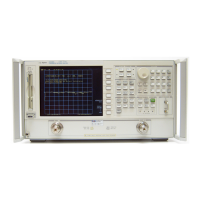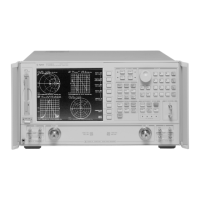Programmer’s Guide 9-5
Introduction to SCPI
The Command Tree
SENSe Configures parameters (such as the frequency and
measurement parameters) related to the sweep and the
measured signal (from the device under test). This
subsystem also controls the narrowband calibration
routines.
SOURce Controls the RF output power level of the source
(power to the device under test).
STATus Contains the commands for using the SCPI status
registers. (For more information about using the status
registers, refer to Chapter 5, “Using Status Registers.”)
SYSTem Contains miscellaneous system configuration
commands (such as I/O port, clock and softkey control).
TEST Performs instrument self-test functions.
TRACe Interfaces with the internal data arrays (functions
such as data transfer and trace memory).
TRIGger Controls the source of the sweep triggering.
When many functions are grouped together on a particular branch,
additional branching is used to organize these functions into groups that
are even more closely related. The branching process continues until
each analyzer function is assigned to its own branch. For example, the
function that turns on and off the marker tracking feature is assigned to
the TRACKING branch of the FUNCTION branch of the MARKER branch of
the CALCULATE subsystem. The command looks like this:
CALCULATE:MARKER:FUNCTION:TRACKING ON
NOTE Colons are used to indicate branching points on the command tree. A
parameter is separated from the rest of the command by a space.

